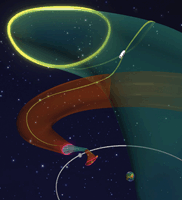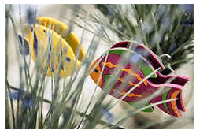And the Star Is . . . Mathematics
April 1, 2010
Hinke Osinga
After several years of work behind the scenes, SIAM has launched the Why Do Math website (whydomath.org). The brainchild of former SIAM president (2005�06) Marty Golubitsky of Ohio State University, Why Do Math collects what he calls "the success stories of mathematics, the stories where mathematics proved to be uniquely insightful in science, society and our everyday lives." The website, made up of nodes, engages the reader with multimedia visualizations; some nodes are accompanied by introductory videos by the authors. Each node tells a layered story, with the information presented becoming more detailed as the reader progresses through the layers.
"With this website," Golubitsky says, "we hope to show that an undergraduate mathematical sciences education can be an entryway to rewarding and engaging career opportunities." Why Do Math is written mainly at the level of college freshmen and sophomores; it should also be accessible to advanced high school students and, in fact, to anyone who is intrigued by what mathematics can do.
Why Do Math is the work of a large team, including current co-directors Marty Golubitsky and Hinke Osinga (University of Bristol, UK) and a steering committee---Chris Budd, University of Bath; John Burns, Virginia Tech; and Peter Turner, Clarkson University---with extensive support from SIAM. The team especially thanks Katherine Socha (St. Mary's College of Maryland) as well as the authors of the nodes, who volunteered their time and communication talents to tell their stories. Why Do Math is an open-ended project: If you work on or know of a story in which mathematics was crucial to the successful outcome, SIAM encourages you to suggest or consider developing a node (contact [email protected] to discuss ideas). For inspiration, and a hint of the flavor of the site, consider the following snapshots of nodes created to date.
*****
In "Space Travel," Shane Ross (Virginia Tech) describes how mathematics revolutionized the way space missions are planned. A dramatic mid-mission rescue of a spacecraft that almost ran out of fuel led mathematicians to reveal an entire interplanetary highway system in which fuel is needed only to change lanes!  Space travel
Space travel
If you decided to run for president of the United States, asks Michael Jones (Montclair State University, New Jersey), would you win? Assuming that you are allowed to run, Jones explains in a node titled "Voting," the outcome of the election would depend not only on how many people vote for you, but also on the procedure for tallying the votes. Mathematics is used to design voting rules, and it turns out that there is no "best" election procedure. In fact, many democracies have voting systems far different from the one used in the U.S.
Have you ever wondered how so many pictures can be stored on a mobile phone? Some very clever and exciting mathematics lies behind the manipulation of images. The node "Wavelets" by Patrick Van Fleet (University of St. Thomas, St. Paul, Minnesota) explains how the red, green, and blue components of an image are extracted and compressed separately in such a way that almost all the information needed to recreate the image is preserved in a much smaller file. The wavelet-based JPEG2000 compression standard was applied to one of the two illustrations above. Can you tell which one?
 Which is the original image?
Which is the original image?
Quite a few people know that Alan Lloyd Hodgkin and Andrew Huxley received a Nobel prize for their groundbreaking work in neuroscience, but many are unaware of the mathematics that helped the two scientists explain why neurons behave the way they thought they would. Once you have seen the node "Neuroscience Mathematics," by Eric Shea-Brown (University of Washington) and Brent Doiron (University of Pittsburgh), you will never feel the same about your brain.
Just as we would be surprised if someone from, say, Kenya won the gold in the 10,000-meter speedskating event at the Winter Olympics, it might seem odd for a team from Switzerland to be a serious competitor in the America's Cup sailing race. But mathematics opens doors, according to Alfio Quarteroni (Ecole Polytechnique F�d�rale de Lausanne), whose node "America's Cup" describes how the Swiss yacht Alinghi won this famous race in 2003 and again in 2007.  The Swiss yacht Alinghi
The Swiss yacht Alinghi
With the node "Tomography," by Chris Budd and Cathryn Mitchell (University of Bath, UK), we learn how mathematics has become an important tool for saving lives. Beginning with the early use of X-rays at the start of the 20th century, modern medicine has relied heavily on imaging methods. And it is not just in medicine that tomography helps to save lives. . . .
The node "Cochlear Implant" by Joseph Skufca (Clarkson University, Potsdam, New York) tells another story of the influence of mathematics on medicine. Skufca's daughter Julianna, who was completely deaf in one ear and losing hearing in the other, got a cochlear implant at the age of three. The design of a cochlear implant requires lots of mathematics, but the true impact is perhaps best phrased by one of Julianna's classmates, who told his mom: "There is a new girl in school. She is so beautiful. And she has a magic ear."  A magic ear
A magic ear
*****
With so many remarkable success stories, the Why Do Math team decided that it is time to launch the site. "Some nodes have been finished for a while and it is about time that we advertise this fantastic material," says Peter Turner.
Additional nodes are under construction---but, as mentioned earlier, ideas and material for new nodes are needed to make Why Do Math a valuable resource for years to come. Please contact [email protected] if you would like to contribute.

